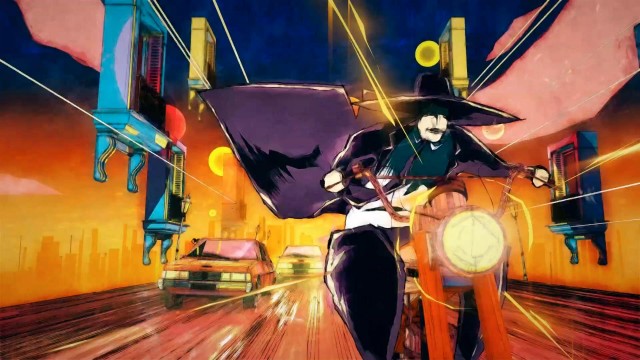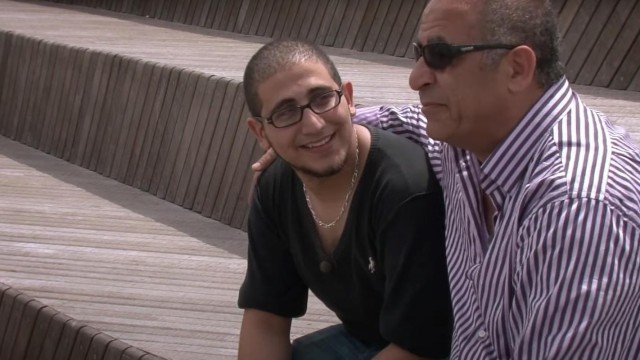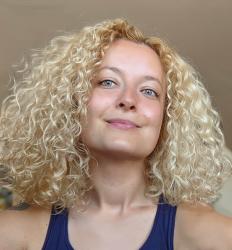What do Osama Bin Laden and Jafar, the villain in Disney’s Aladdin, have in common? No, this is not a racist joke… They are two metaphysical manifestations of a father figure conjured up by Tim – a French-Iraqi Jew going through an identity crisis. With 5 ans après la guerre (5 years after the war), a seventeen-minute animated documentary co-directed by Samuel Albaric, Martin Wiklund and Ulysse Lefort, it’s easy to see why one might consider the best way to approach this film is in a chemically altered state. However, this simultaneously grounded and otherworldly story is so captivating and innovative that you’d struggle to absorb and appreciate its genius unless all your senses were intact. Even then, you might be compelled to watch it again, just to savour its delicious humour and warming charm.
5 ans après la guerre tells the true story of co-director Samuel Albaric’s cousin Tim – a man drifting through the motions of life whilst trying to find his place in it. Growing up in Paris without a dad, Tim found solace in the fact that his favourite superheroes, worshipped by his peers, were also fatherless. But being born to a Jewish mother and an Arab father, who was also a war refugee, proved more challenging to process and accept. Told through a series of rotoscoped interviews and brought to life with exquisite 2D animated sequences, Tim’s quest to find his identity is a candid and deeply personal adventure that tugs at the heartstrings and ignites the imagination.

One of the impressive animated sequences from 5 ans après la guerre
Rotoscoping, an animation technique that involves tracing over live-action footage, was put in the spotlight by Richard Linklater’s Waking Life in 2001. Back then, it seemed refreshingly different from the glitzy CGI stuff and it wowed audiences with its ability to take hyper-realism and twist it into a throbbing, pulsating and forever resettling artistic form. Now rotoscoping is largely seen as easy at best and unimaginative at worst – something I have made my personal mission in life to disprove. With this in mind, when I come across a rotoscoped film as good as 5 ans après la guerre, I do a little victory dance and enthusiastically raise two middle fingers to the naysayers.
The craft on display here, with its hallucinatory, dream-like qualities, is truly mind-blowing. The rotoscoped sections are beautifully designed – with shimmery, intricately detailed backgrounds washed in warm, watercolour tones, and the character of Tim rendered in vibrant colours and dark outlines which seem alive. No one can accuse the animators of being lazy here. Rotoscoping a film this length is painstaking and mindf*cking work. To prove the point, the filmmakers have gone a hundred steps further and crafted extensive 2D animated sequences too. As if ripped straight out of the pages of a comic book, these sequences depict familiar, yet distinctly original characters shaped with inky shading and framed by loud action lines, the cumulative effect of which is dazzling.

The scene where Tim meets his Dad is the only piece of live-action in 5 ans apres la guerre
There is one live-action scene in the film – the one where Tim meets his dad. The decision not to animate this footage was another stroke of genius since it would’ve altered and distorted an already perfect human moment. Many filmmakers would’ve undoubtedly considered this a great scene to end on, but not our directorial trio – a decision for which I applaud them once again. Because life rarely gifts us beautifully wrapped resolutions that solve all our issues and more often than not, what we desire the most is not what we usually need. For Tim, the hard work to discover himself only just began after his long-anticipated reunion with his dad. And that’s OK.
Much like waking up after a big night, 5 ans après la guerre leaves you a little woozy and confused, maybe fighting the urge to get stuck into some cheesy carbs. You might also have some lingering questions – about the story or maybe the craft – that might propel a second watch. And that’s OK too. Because this is thrilling and cerebral state of the art filmmaking at its finest, and if that doesn’t deserve another look, I don’t know what does.

 Serafima Serafimova
Serafima Serafimova